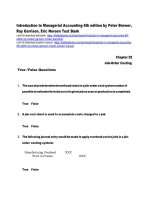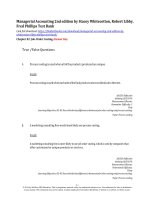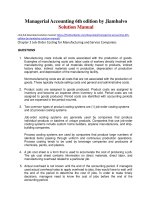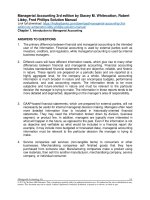Managerial accounting 16th edition by garrison noreen brewer solution manual
Bạn đang xem bản rút gọn của tài liệu. Xem và tải ngay bản đầy đủ của tài liệu tại đây (8.68 MB, 198 trang )
Managerial Accounting 16th edition by Ray H. Garrison, Eric
Noreen, Peter C. Brewer Solution Manual
Link full download solution manual: />Link full download test bank: />
Chapter 2: Job-Order Costing: Calculating Unit
Production Costs
2-1 Job-order costing is used in situations where
many different products, each with individ-ual
and unique features, are produced each pe-riod.
2-2 In absorption costing, all manufacturing costs,
both fixed and variable, are assigned to units of
product—units are said to fully absorb
manufacturing costs. Conversely, all nonmanufacturing costs are treated as period costs and they are
not assigned to units of product.
2-3 Normal costing systems apply overhead
costs to jobs by multiplying a predetermined
overhead rate by the actual amount of the
alloca-tion incurred by the job.
2-4 Unit product cost is computed by taking
the total manufacturing costs assigned to a job
and dividing it by the number of units
contained in the job.
2-5 The first step is to estimate the total amount
of the allocation base (the denominator) that will
be required for next period’s estimated level of
production. The second step is to esti-mate the
total fixed manufacturing overhead cost for the
coming period and the variable manufac-turing
overhead cost per unit of the allocation base.
The third step is to use the cost formula Y
= a + bX to estimate the total manufacturing
overhead cost (the numerator) for the coming
pe-riod. The fourth step is to compute the
predeter-mined overhead rate.
2-6 The job cost sheet is used to record all costs
that are assigned to a particular job. These costs
include direct materials costs traced to the job,
direct labor costs traced to the job, and manufacturing overhead costs applied to the job.
When a job is completed, the job cost sheet
is used to compute the unit product cost.
2-7 Some production costs such as a factory
manager’s salary cannot be traced to a particular
product or job, but rather are incurred as a result
of overall production activities. In addition, some
production costs such as indirect materials
cannot be easily traced to jobs. If these costs are
to be assigned to products, they must be
allocated to the products.
2-8 If actual manufacturing overhead cost is
applied to jobs, the company must wait until the
end of the accounting period to apply overhead
and to cost jobs. If the company computes actual
overhead rates more frequently to get around
this problem, the rates may fluctuate widely due
to seasonal factors or variations in output. For
this reason, most companies use predetermined
over-head rates to apply manufacturing overhead
costs to jobs.
2-9 The measure of activity used as the allocation base should drive the overhead cost; that
is, the allocation base should cause the
overhead cost. If the allocation base does not
really cause the overhead, then costs will be
incorrectly at-tributed to products and jobs and
product costs will be distorted.
2-10 Assigning manufacturing overhead costs
to jobs does not ensure a profit. The units produced may not be sold and if they are sold,
they may not be sold at prices sufficient to
cover all costs. It is a myth that assigning costs
to prod-ucts or jobs ensures that those costs
will be re-covered. Costs are recovered only by
selling to customers—not by allocating costs.
© The McGraw-Hill Companies, Inc., 2018. All rights reserved.
Solutions Manual, Chapter 2
1
2-11 No, you would not expect the total applied overhead for a period to equal the actual
overhead for that period. This is because the applied overhead relies on a predetermined overhead rate that is based on estimates in the numerator and denominator.
2-12 When a company applied less overhead to
production than it actually incurs, it creates what
is known as underapplied overhead. When it
applies more overhead to production than it actually incurs, it results in overapplied overhead.
2-13 A plantwide overhead rate is a single
overhead rate used throughout a plant. In a multiple overhead rate system, each production department may have its own predetermined overhead rate and its own allocation base. Some companies use multiple overhead rates rather than
plantwide rates to more appropriately allocate
overhead costs among products. Multiple over-head
rates should be used, for example, in situa-tions
where one department is machine intensive and
another department is labor intensive.
© The McGraw-Hill Companies, Inc., 2018. All rights reserved.
2
Managerial Accounting, 16th edition
Chapter 2: Applying Excel
The completed worksheet is shown below.
© The McGraw-Hill Companies, Inc., 2018. All rights reserved.
Solutions Manual, Chapter 2
3
Chapter 2: Applying Excel (continued)
The completed worksheet, with formulas displayed, is shown below.
© The McGraw-Hill Companies, Inc., 2018. All rights reserved.
4
Managerial Accounting, 16th edition
Chapter 2: Applying Excel (continued)
[Note: To display formulas in Excel 2013, select File > Options > Advanced
> Display options for this worksheet > Show formulas in cells instead of
their calculated amounts. To display the formulas in other versions of Excel, consult Excel Help.]
© The McGraw-Hill Companies, Inc., 2018. All rights reserved.
Solutions Manual, Chapter 2
5
Chapter 2: Applying Excel (continued)
1. When the total fixed manufacturing overhead cost for the Milling Department is changed to $300,000, the worksheet changes as show
be-low:
© The McGraw-Hill Companies, Inc., 2018. All rights reserved.
6
Managerial Accounting, 16th edition
Chapter 2: Applying Excel (continued)
The selling price of Job 407 has dropped from $4,348.75 to $4,112.50
because the fixed manufacturing overhead in the Milling Department decreased from $390,000 to $ 300,000. This reduced the predetermined
overhead rate in the Milling Department from $8.50 per machine-hour to
$7.00 per machine-hour and hence the amount of overhead applied to
Job 407 in the Milling Department.
© The McGraw-Hill Companies, Inc., 2018. All rights reserved.
Solutions Manual, Chapter 2
7
Chapter 2: Applying Excel (continued)
2. For the new Job 408, the worksheet should look like the following:
© The McGraw-Hill Companies, Inc., 2018. All rights reserved.
8
Managerial Accounting, 16th edition
Chapter 2: Applying Excel (continued)
3. When the total number of machine-hours in the Assembly Department
increases from 3,000 machine-hours to 6,000 machine-hours, the worksheet looks like the following:
© The McGraw-Hill Companies, Inc., 2018. All rights reserved.
Solutions Manual, Chapter 2
9
Chapter 2: Applying Excel (continued)
The selling price for Job 408 is not affected by this change. The reason
for this is that the total number of machine-hours in the Assembly Department has no effect on any cost. There would have been a change in
costs and in the selling price if the total machine-hours in the Milling Department would have changed. This is because the predetermined overhead rate in that department is based on machine-hours and any
change in the total machine-hours would affect the magnitude of the
predetermined overhead rate in that department.
© The McGraw-Hill Companies, Inc., 2018. All rights reserved.
10
Managerial Accounting, 16th edition
Chapter 2: Applying Excel (continued)
4. When the total number of direct labor-hours in the Assembly Department decreases from 80,000 direct labor-hours to 50,000 direct laborhours, the worksheet looks like the following:
© The McGraw-Hill Companies, Inc., 2018. All rights reserved.
Solutions Manual, Chapter 2
11
Chapter 2: Applying Excel (continued)
The selling price of Job 408 has increased from $2,905.00 to $2,944.38.
This occurs because the decrease in the total number of direct laborhours in the Assembly Department increases the predetermined overhead rate in that department from $10.00 per direct labor-hour to
$13.75 per direct labor-hour. In effect, the same total fixed manufacturing overhead cost is spread across fewer total direct labor-hours.
© The McGraw-Hill Companies, Inc., 2018. All rights reserved.
12
Managerial Accounting, 16th edition
The Foundational 15
1. The first step is to calculate the estimated total overhead costs in Molding and Fabrication:
Molding: Using the equation Y = a + bX, the estimated total manufacturing overhead cost is computed as follows:
Y = $10,000 + ($1.40 per MH)(2,500 MHs)
Estimated fixed manufacturing overhead ..................
$10,000
Estimated variable manufacturing overhead:
$1.40 per MH × 2,500 MHs ...................................
3,500
Estimated total manufacturing overhead cost............
$13,500
Fabrication: Using the equation Y = a + bX, the estimated total
manu-facturing overhead cost is computed as follows:
Y = $15,000 + ($2.20 per MH)(1,500 MHs)
Estimated fixed manufacturing overhead ..................
$15,000
Estimated variable manufacturing overhead:
$2.20 per MH × 1,500 MHs ...................................
3,300
Estimated total manufacturing overhead cost............
$18,300
The second step is to combine the estimated manufacturing overhead
costs in Molding and Fabrication ($ 13,500 + $18,300 = $31,800) to
en-able calculating the predetermined overhead rate as follows:
Estimated total manufacturing overhead (a) .
Estimated total machine-hours (MHs) (b)........
Predetermined overhead rate (a) ÷ (b).........
$31,800
4,000 MHs
$7.95 per MH
2. The manufacturing overhead applied to Jobs P and Q is computed as
follows:
Actual machine-hours worked (a) .................
Predetermined overhead rate per MH (b) ......
Manufacturing overhead applied (a) × (b) ....
Job P
Job Q
2,300
1,700
$7.95
$7.95
$18,285 $13,515
© The McGraw-Hill Companies, Inc., 2018. All rights reserved.
Solutions Manual, Chapter 2
13
The Foundational 15
3. The total manufacturing cost assigned to Job P is computed as follows:
Job P
Direct materials ...........................................
Direct labor .................................................
Manufacturing overhead applied...................
Total manufacturing cost..............................
$13,000
21,000
18,285
$52,285
4. Job P’s unit product cost is computed as follows:
Job P
Total manufacturing cost (a) .......................... $52,285
Number of units (b).......................................
20
Unit product cost (rounded) (a) ÷ (b).............
$2,614
5. The total manufacturing cost assigned to Job Q is computed as follows:
Job P
Direct materials ...........................................
Direct labor .................................................
Manufacturing overhead applied...................
Total manufacturing cost..............................
$ 8,000
7,500
13,515
$29,015
6. Job Q’s unit product cost is computed as follows:
Job P
Total manufacturing cost (a) .......................... $29,015
Number of units (b).......................................
30
Unit product cost (rounded) (a) ÷ (b).............
$967
7. The selling prices are calculated as follows:
Total manufacturing cost..............................
Markup (based on 80%) ..............................
Total price for the job (a) .............................
Number of units in the job (b)......................
Selling price per unit (rounded) (a) ÷ (b)......
Job P
$52,285
41,828
$94,113
20
$4,706
Job Q
$29,015
23,212
$52,227
30
$1,741
© The McGraw-Hill Companies, Inc., 2018. All rights reserved.
14
Managerial Accounting, 16th edition
The Foundational 15
8. The cost of goods sold is the sum of the manufacturing costs assigned
to Jobs P and Q:
Total manufacturing cost assigned to Job P ..... $52,285
Total manufacturing cost assigned to Job Q .... 29,015
Cost of goods sold......................................... $81,300
9. Molding: Using the equation Y = a + bX, the estimated total manufacturing overhead cost is computed as follows:
Y = $10,000 + ($1.40 per MH)(2,500 MHs)
Estimated fixed manufacturing overhead ..................
$10,000
Estimated variable manufacturing overhead:
$1.40 per MH × 2,500 MHs ...................................
3,500
Estimated total manufacturing overhead cost............
$13,500
The predetermined overhead rate in Molding is computed as follows:
Estimated total manufacturing overhead (a) ...
Estimated total machine-hours (MHs) (b)........
Predetermined overhead rate (a) ÷ (b)...........
$13,500
2,500 MHs
$5.40 per MH
Fabrication: Using the equation Y = a + bX, the estimated total
manu-facturing overhead cost is computed as follows:
Y = $15,000 + ($2.20 per MH)(1,500 MHs)
Estimated fixed manufacturing overhead ..................
$15,000
Estimated variable manufacturing overhead:
$2.20 per MH × 1,500 MHs ...................................
3,300
Estimated total manufacturing overhead cost............
$18,300
The predetermined overhead rate in Fabrication is computed as follows:
Estimated total manufacturing overhead (a) ...
Estimated total machine-hours (MHs) (b)........
Predetermined overhead rate (a) ÷ (b)...........
$18,300
1,500 MHs
$12.20 per MH
© The McGraw-Hill Companies, Inc., 2018. All rights reserved.
Solutions Manual, Chapter 2
15
The Foundational 15
10. The applied overhead from Molding is computed as follows:
Machine-hours worked on job (a) .................
Molding overhead rate (b)............................
Manufacturing overhead applied (a) × (b) ....
Job P
1,700
$5.40
$9,180
Job Q
800
$5.40
$4,320
11. The applied overhead from Fabrication is computed as follows:
Machine-hours worked on job (a) .................
Fabrication overhead rate (b) .......................
Manufacturing overhead applied (a) × (b) ....
Job P
Job Q
600
900
$12.20 $12.20
$7,320 $10,980
12. The unit product cost for Job P is computed as follows:
Direct materials ..........................................
Direct labor ................................................
Manufacturing overhead applied:
Molding Department .................................
Fabrication Department ............................
Total manufacturing cost (a) .......................
Number of units in the job (b).....................
Unit product cost (a) ÷ (b)..........................
$13,000
21,000
$9,180
7,320
16,500
$50,500
20
$2,525
13. The unit product cost for Job Q is computed as follows:
Direct materials ..........................................
Direct labor ................................................
Manufacturing overhead applied:
Molding Department .................................
Fabrication Department ............................
Total manufacturing cost (a) .......................
Number of units in the job (b).....................
Unit product cost (rounded) (a) ÷ (b) ..........
$8,000
7,500
$4,320
10,980
15,300
$30,800
30
$1,027
© The McGraw-Hill Companies, Inc., 2018. All rights reserved.
16
Managerial Accounting, 16th edition
The Foundational 15
14. The selling prices are calculated as follows:
Total manufacturing cost..............................
Markup (based on 80%) ..............................
Total price for the job (a) .............................
Number of units in the job (b)......................
Selling price per unit (a) ÷ (b) .....................
Job P
$50,500
40,400
$90,900
20
$4,545
Job Q
$30,800
24,640
$55,440
30
$1,848
15. The cost of goods sold is the sum of the manufacturing costs assigned
to Jobs P and Q:
Total manufacturing cost assigned to Job P ..... $50,500
Total manufacturing cost assigned to Job Q .... 30,800
Cost of goods sold......................................... $81,300
© The McGraw-Hill Companies, Inc., 2018. All rights reserved.
Solutions Manual, Chapter 2
17
Exercise 2-1 (10 minutes)
The estimated total manufacturing overhead cost is computed as follows:
Y = $94,000 + ($2.00 per DLH)(20,000 DLHs)
Estimated fixed manufacturing overhead .................. $ 94,000
Estimated variable manufacturing overhead: $2.00
per DLH × 20,000 DLHs ........................................
40,000
Estimated total manufacturing overhead cost............ $134,000
The plantwide predetermined overhead rate is computed as follows:
Estimated total manufacturing overhead (a)......
Estimated total direct labor hours (b)................
Predetermined overhead rate (a) ÷ (b) .............
$134,000
20,000 DLHs
$6.70 per DLH
© The McGraw-Hill Companies, Inc., 2018. All rights reserved.
18
Managerial Accounting, 16th edition
Exercise 2-2 (10 minutes)
Actual direct labor-hours (a)........................
Predetermined overhead rate (b).................
Manufacturing overhead applied (a) × (b)....
10,800
$23.40
$252,720
© The McGraw-Hill Companies, Inc., 2018. All rights reserved.
Solutions Manual, Chapter 2
19
Exercise 2-3 (10 minutes)
1. Total direct labor-hours required for Job A-500:
Direct labor cost (a).................................................................................. $153
Direct labor wage rate per hour (b) ............................................... $17
Total direct labor hours (a) ÷ (b)........................................................... 9
Total manufacturing cost assigned to Job A-500:
Direct materials .............................................................................................................$231
Direct labor ..........................................................................................................................153
Manufacturing overhead applied ($14 per DLH × 9
DLHs) ...................................................................................................................................126
Total manufacturing cost ......................................................................................$510
2. Unit product cost for Job A-500:
Total manufacturing cost (a)............................................................. $510
Number of units in the job (b) ............................................................... 40
Unit product cost (a) ÷ (b) ............................................................ $12.75
© The McGraw-Hill Companies, Inc., 2018. All rights reserved.
20
Managerial Accounting, 16th edition
Exercise 2-4 (10 minutes)
1 and 2.
The total direct labor-hours required for Job N-60:
Direct labor cost (a) .....................................
Direct labor wage rate per hour (b) ...............
Total direct labor hours (a) ÷ (b) ..................
Assembly
$180
$20
9
Testing &
Packaging
$40
$20
2
The total manufacturing cost and unit product cost for Job N-60 is
com-puted as follows:
Direct materials ($340 + $25) ................................
Direct labor ($180 + $40) ......................................
Assembly Department ($16 per DLH × 9 DLHs) .......
Testing & Packaging Department ($12 per DLH × 2
DLHs) .................................................................
Total manufacturing cost........................................
Total manufacturing cost (a) ..................................
Number of units in the job (b) ................................
Unit product cost (a) ÷ (b) .....................................
$144
24
$365
220
168
$753
$753
10
$75.30
© The McGraw-Hill Companies, Inc., 2018. All rights reserved.
Solutions Manual, Chapter 2
21
Exercise 2-5 (10 minutes)
1 and 2.
The total direct labor-hours required in Finishing for Job 700:
Finishing
Direct labor cost (a).................................................................................. $128
Direct labor wage rate per hour (b) ............................................... $16
Total direct labor hours (a) ÷ (b)........................................................... 8
The total manufacturing cost and unit product cost for Job 700 is computed
as follows:
Direct materials ($410 + $60) ................................
Direct labor ($128 + $48) ......................................
Finishing Department ($18 per DLH × 8 DLHs)........
Fabrication Department (110% × $60) ...................
Total manufacturing cost........................................
Total manufacturing cost (a) ..................................
Number of units in the job (b) ................................
Unit product cost (rounded) (a) ÷ (b) .....................
$144
66
$470
176
210
$856
$856
15
$57.07
© The McGraw-Hill Companies, Inc., 2018. All rights reserved.
22
Managerial Accounting, 16th edition
Exercise 2-6 (10 minutes)
1. The estimated total overhead cost is computed as follows:
Y = $680,000 + ($0.50 per DLH)(80,000 DLHs)
Estimated fixed overhead cost ................................
Estimated variable overhead cost: $0.50 per DLH ×
80,000 DLHs .......................................................
Estimated total overhead cost ................................
$680,000
40,000
$720,000
The predetermined overhead rate is computed as follows:
Estimated total overhead (a)......................
Estimated total direct labor-hours (b) .........
Predetermined overhead rate (a) ÷ (b).......
$720,000
80,000 DLHs
$9.00 per DLH
2. Total manufacturing cost assigned to Xavier:
Direct materials .......................................................
Direct labor .............................................................
Overhead applied ($9.00 per DLH × 280 DLHs).........
Total manufacturing cost..........................................
$38,000
21,000
2,520
$61,520
© The McGraw-Hill Companies, Inc., 2018. All rights reserved.
Solutions Manual, Chapter 2
23
Exercise 2-7 (20 minutes)
1. Step 1: The total direct labor-hours required for Job Omega:
Direct labor cost (a) .....................................
Direct labor wage rate per hour (b) ...............
Total direct labor hours worked (a) ÷ (b) ......
$345,000
$15
23,000
Step 2: Derive the plantwide predetermined overhead rate:
Manufacturing overhead applied to Job
Omega (a) ................................................
Direct labor hours worked on Job Omega (b) .
Plantwide predetermined overhead rate (a)
÷ (b) ........................................................
$184,000
23,000
$8.00 per DLH
2. The job cost sheet for Job Alpha is derived as follows: (note that
direct materials is the plug figure)
Direct materials (plug figure)................................. $ 280,000
Direct labor (54,500 DLHs × $15 per DLH) ............
817,500
Manufacturing overhead applied ($8 per DLH ×
54,500 DLHs) ....................................................
436,000
Total job cost (given) ............................................ $1,533,500
© The McGraw-Hill Companies, Inc., 2018. All rights reserved.
24
Managerial Accounting, 16th edition
Exercise 2-8 (10 minutes)
Direct material................................
Direct labor ....................................
Manufacturing overhead applied:
$12,000 × 125% .........................
Total manufacturing cost ................
$10,000
12,000
Total manufacturing cost (a) ...........
Number of units in job (b)...............
Unit product cost (a) ÷ (b)..............
$37,000
1,000
$37
15,000
$37,000
© The McGraw-Hill Companies, Inc., 2018. All rights reserved.
Solutions Manual, Chapter 2
25









